Employee Motivation and Organizational Performance: Research Proposal
VerifiedAdded on 2023/02/01
|12
|2274
|48
Project
AI Summary
This research proposal investigates the impact of employee motivation on organizational performance, focusing on the context of Stansted Airport. The study aims to analyze motivational factors, identify challenges, and propose solutions to improve performance. The literature review covers the concept of employee motivation, its role in organizations, motivational factors (leadership, reward systems, work structure, organizational culture), and the interrelationship between motivation and performance. Theoretical aspects, including Maslow's hierarchy of needs and Herzberg's two-factor theory, are discussed. The research methodology involves both primary and secondary data collection methods, including surveys and interviews with Stansted Airport employees and managers. A random sampling method will be used, with a sample size of 100 employees and 5 managers. Ethical considerations and potential limitations are also addressed, along with a detailed time plan for the research activities.
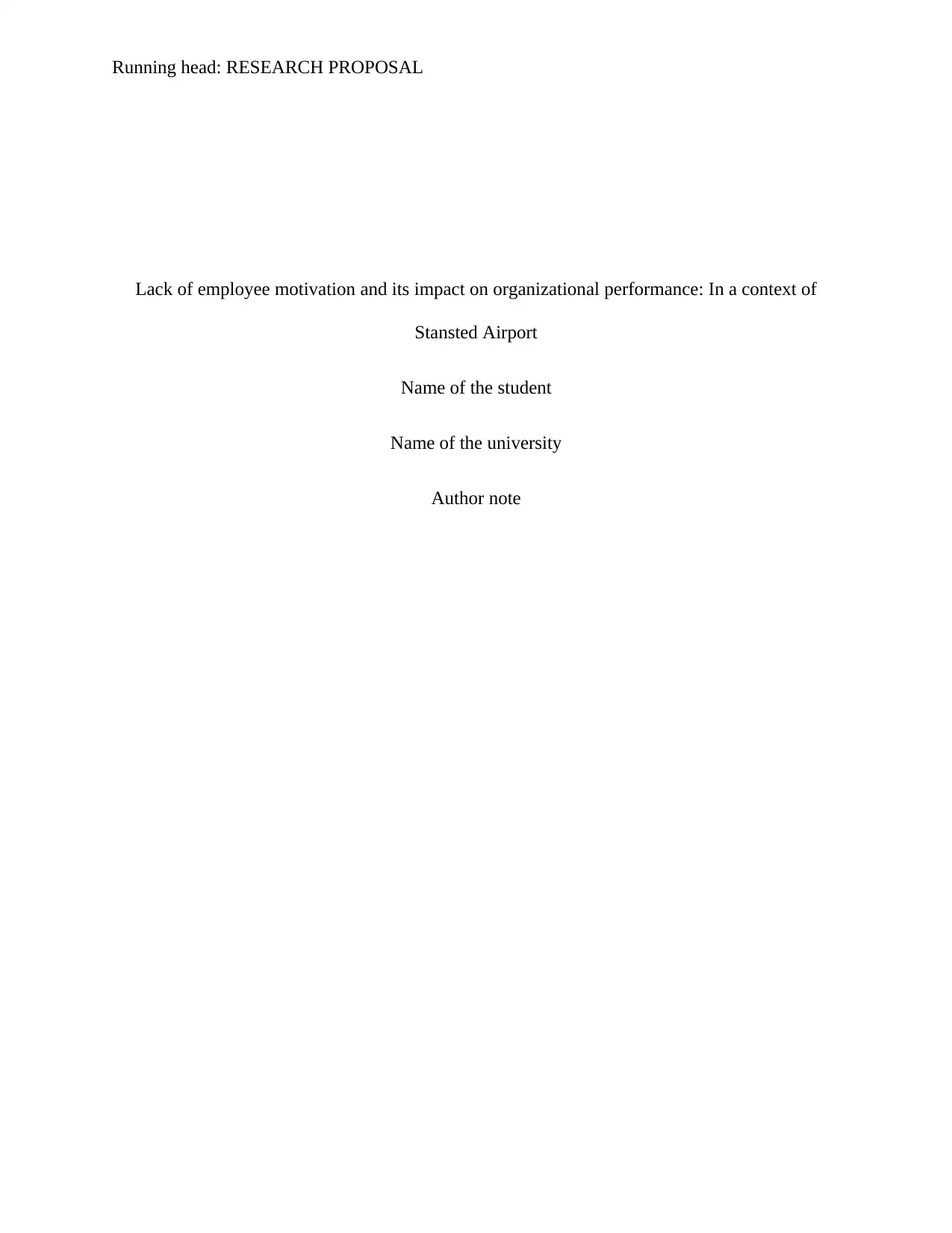
Running head: RESEARCH PROPOSAL
Lack of employee motivation and its impact on organizational performance: In a context of
Stansted Airport
Name of the student
Name of the university
Author note
Lack of employee motivation and its impact on organizational performance: In a context of
Stansted Airport
Name of the student
Name of the university
Author note
Paraphrase This Document
Need a fresh take? Get an instant paraphrase of this document with our AI Paraphraser
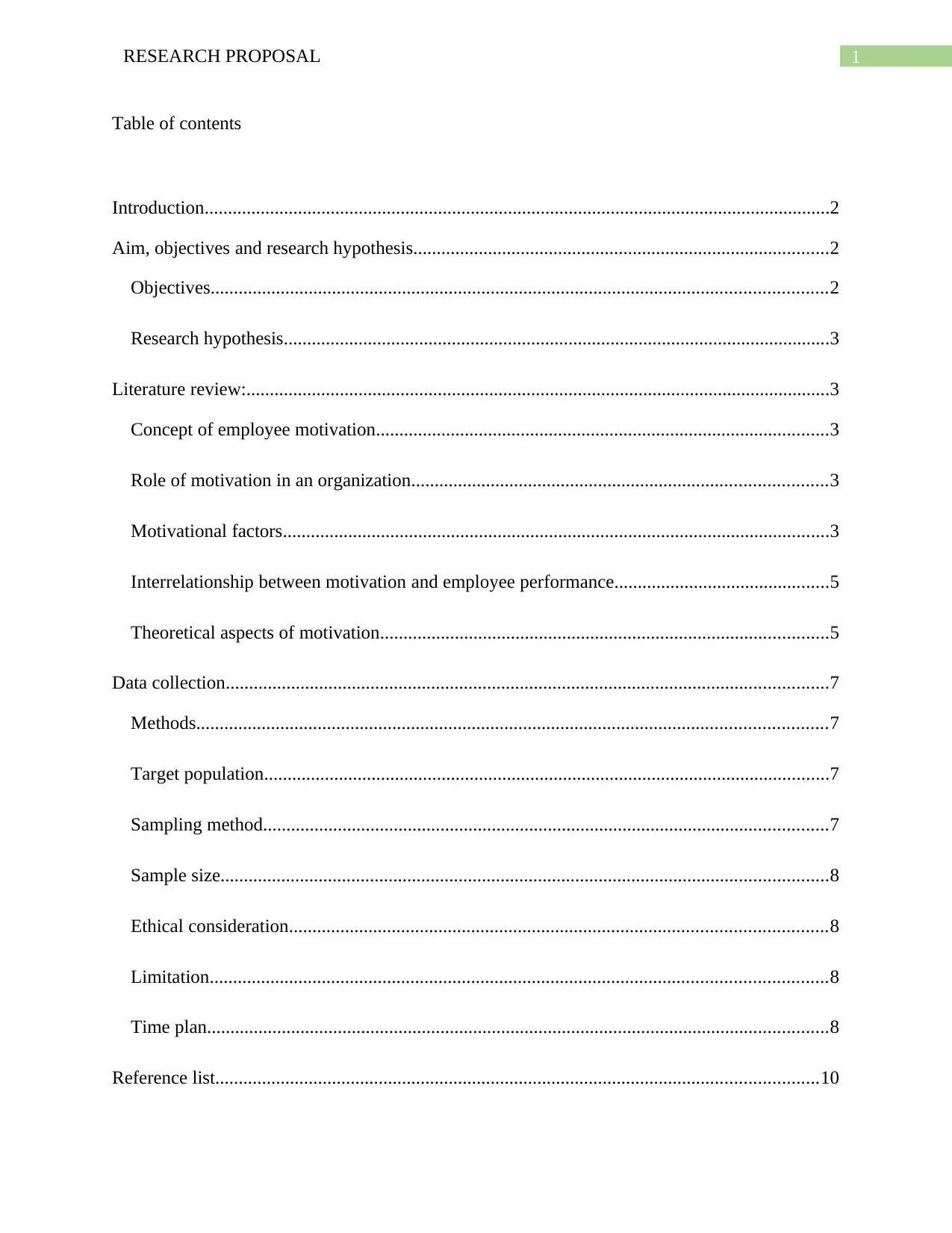
1RESEARCH PROPOSAL
Table of contents
Introduction......................................................................................................................................2
Aim, objectives and research hypothesis.........................................................................................2
Objectives....................................................................................................................................2
Research hypothesis.....................................................................................................................3
Literature review:.............................................................................................................................3
Concept of employee motivation.................................................................................................3
Role of motivation in an organization.........................................................................................3
Motivational factors.....................................................................................................................3
Interrelationship between motivation and employee performance..............................................5
Theoretical aspects of motivation................................................................................................5
Data collection.................................................................................................................................7
Methods.......................................................................................................................................7
Target population.........................................................................................................................7
Sampling method.........................................................................................................................7
Sample size..................................................................................................................................8
Ethical consideration...................................................................................................................8
Limitation....................................................................................................................................8
Time plan.....................................................................................................................................8
Reference list.................................................................................................................................10
Table of contents
Introduction......................................................................................................................................2
Aim, objectives and research hypothesis.........................................................................................2
Objectives....................................................................................................................................2
Research hypothesis.....................................................................................................................3
Literature review:.............................................................................................................................3
Concept of employee motivation.................................................................................................3
Role of motivation in an organization.........................................................................................3
Motivational factors.....................................................................................................................3
Interrelationship between motivation and employee performance..............................................5
Theoretical aspects of motivation................................................................................................5
Data collection.................................................................................................................................7
Methods.......................................................................................................................................7
Target population.........................................................................................................................7
Sampling method.........................................................................................................................7
Sample size..................................................................................................................................8
Ethical consideration...................................................................................................................8
Limitation....................................................................................................................................8
Time plan.....................................................................................................................................8
Reference list.................................................................................................................................10
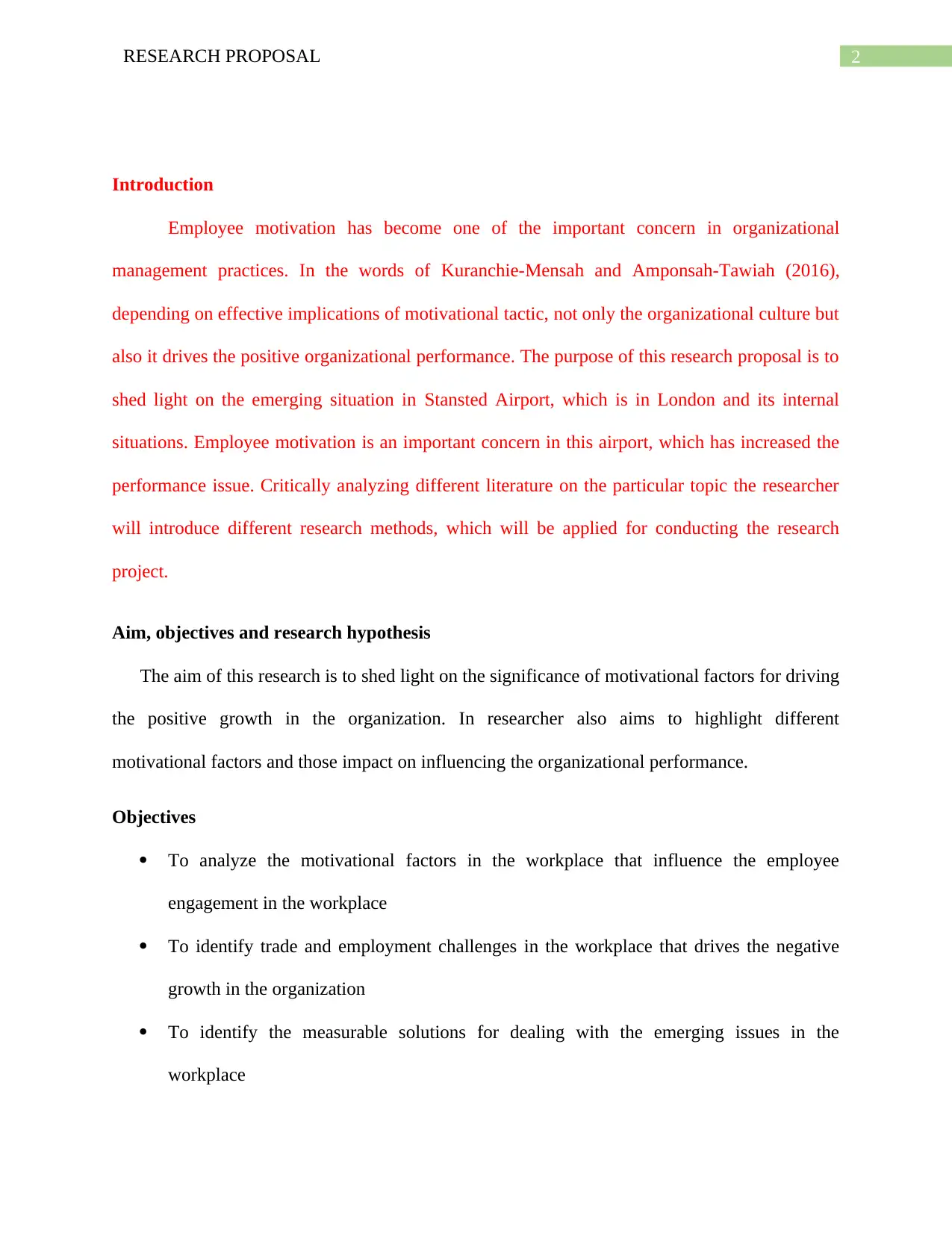
2RESEARCH PROPOSAL
Introduction
Employee motivation has become one of the important concern in organizational
management practices. In the words of Kuranchie-Mensah and Amponsah-Tawiah (2016),
depending on effective implications of motivational tactic, not only the organizational culture but
also it drives the positive organizational performance. The purpose of this research proposal is to
shed light on the emerging situation in Stansted Airport, which is in London and its internal
situations. Employee motivation is an important concern in this airport, which has increased the
performance issue. Critically analyzing different literature on the particular topic the researcher
will introduce different research methods, which will be applied for conducting the research
project.
Aim, objectives and research hypothesis
The aim of this research is to shed light on the significance of motivational factors for driving
the positive growth in the organization. In researcher also aims to highlight different
motivational factors and those impact on influencing the organizational performance.
Objectives
To analyze the motivational factors in the workplace that influence the employee
engagement in the workplace
To identify trade and employment challenges in the workplace that drives the negative
growth in the organization
To identify the measurable solutions for dealing with the emerging issues in the
workplace
Introduction
Employee motivation has become one of the important concern in organizational
management practices. In the words of Kuranchie-Mensah and Amponsah-Tawiah (2016),
depending on effective implications of motivational tactic, not only the organizational culture but
also it drives the positive organizational performance. The purpose of this research proposal is to
shed light on the emerging situation in Stansted Airport, which is in London and its internal
situations. Employee motivation is an important concern in this airport, which has increased the
performance issue. Critically analyzing different literature on the particular topic the researcher
will introduce different research methods, which will be applied for conducting the research
project.
Aim, objectives and research hypothesis
The aim of this research is to shed light on the significance of motivational factors for driving
the positive growth in the organization. In researcher also aims to highlight different
motivational factors and those impact on influencing the organizational performance.
Objectives
To analyze the motivational factors in the workplace that influence the employee
engagement in the workplace
To identify trade and employment challenges in the workplace that drives the negative
growth in the organization
To identify the measurable solutions for dealing with the emerging issues in the
workplace
⊘ This is a preview!⊘
Do you want full access?
Subscribe today to unlock all pages.

Trusted by 1+ million students worldwide
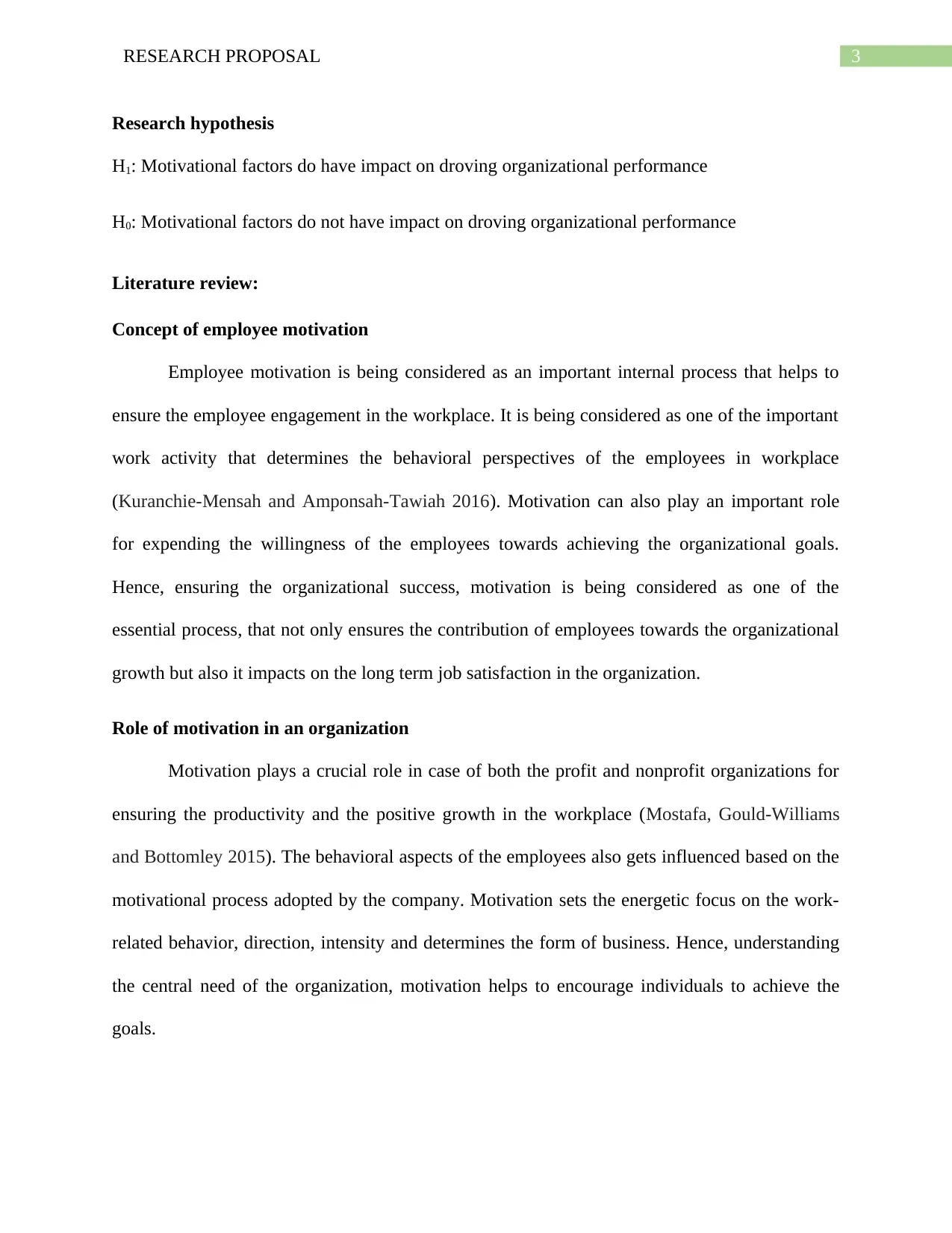
3RESEARCH PROPOSAL
Research hypothesis
H1: Motivational factors do have impact on droving organizational performance
H0: Motivational factors do not have impact on droving organizational performance
Literature review:
Concept of employee motivation
Employee motivation is being considered as an important internal process that helps to
ensure the employee engagement in the workplace. It is being considered as one of the important
work activity that determines the behavioral perspectives of the employees in workplace
(Kuranchie-Mensah and Amponsah-Tawiah 2016). Motivation can also play an important role
for expending the willingness of the employees towards achieving the organizational goals.
Hence, ensuring the organizational success, motivation is being considered as one of the
essential process, that not only ensures the contribution of employees towards the organizational
growth but also it impacts on the long term job satisfaction in the organization.
Role of motivation in an organization
Motivation plays a crucial role in case of both the profit and nonprofit organizations for
ensuring the productivity and the positive growth in the workplace (Mostafa, Gould‐Williams
and Bottomley 2015). The behavioral aspects of the employees also gets influenced based on the
motivational process adopted by the company. Motivation sets the energetic focus on the work-
related behavior, direction, intensity and determines the form of business. Hence, understanding
the central need of the organization, motivation helps to encourage individuals to achieve the
goals.
Research hypothesis
H1: Motivational factors do have impact on droving organizational performance
H0: Motivational factors do not have impact on droving organizational performance
Literature review:
Concept of employee motivation
Employee motivation is being considered as an important internal process that helps to
ensure the employee engagement in the workplace. It is being considered as one of the important
work activity that determines the behavioral perspectives of the employees in workplace
(Kuranchie-Mensah and Amponsah-Tawiah 2016). Motivation can also play an important role
for expending the willingness of the employees towards achieving the organizational goals.
Hence, ensuring the organizational success, motivation is being considered as one of the
essential process, that not only ensures the contribution of employees towards the organizational
growth but also it impacts on the long term job satisfaction in the organization.
Role of motivation in an organization
Motivation plays a crucial role in case of both the profit and nonprofit organizations for
ensuring the productivity and the positive growth in the workplace (Mostafa, Gould‐Williams
and Bottomley 2015). The behavioral aspects of the employees also gets influenced based on the
motivational process adopted by the company. Motivation sets the energetic focus on the work-
related behavior, direction, intensity and determines the form of business. Hence, understanding
the central need of the organization, motivation helps to encourage individuals to achieve the
goals.
Paraphrase This Document
Need a fresh take? Get an instant paraphrase of this document with our AI Paraphraser
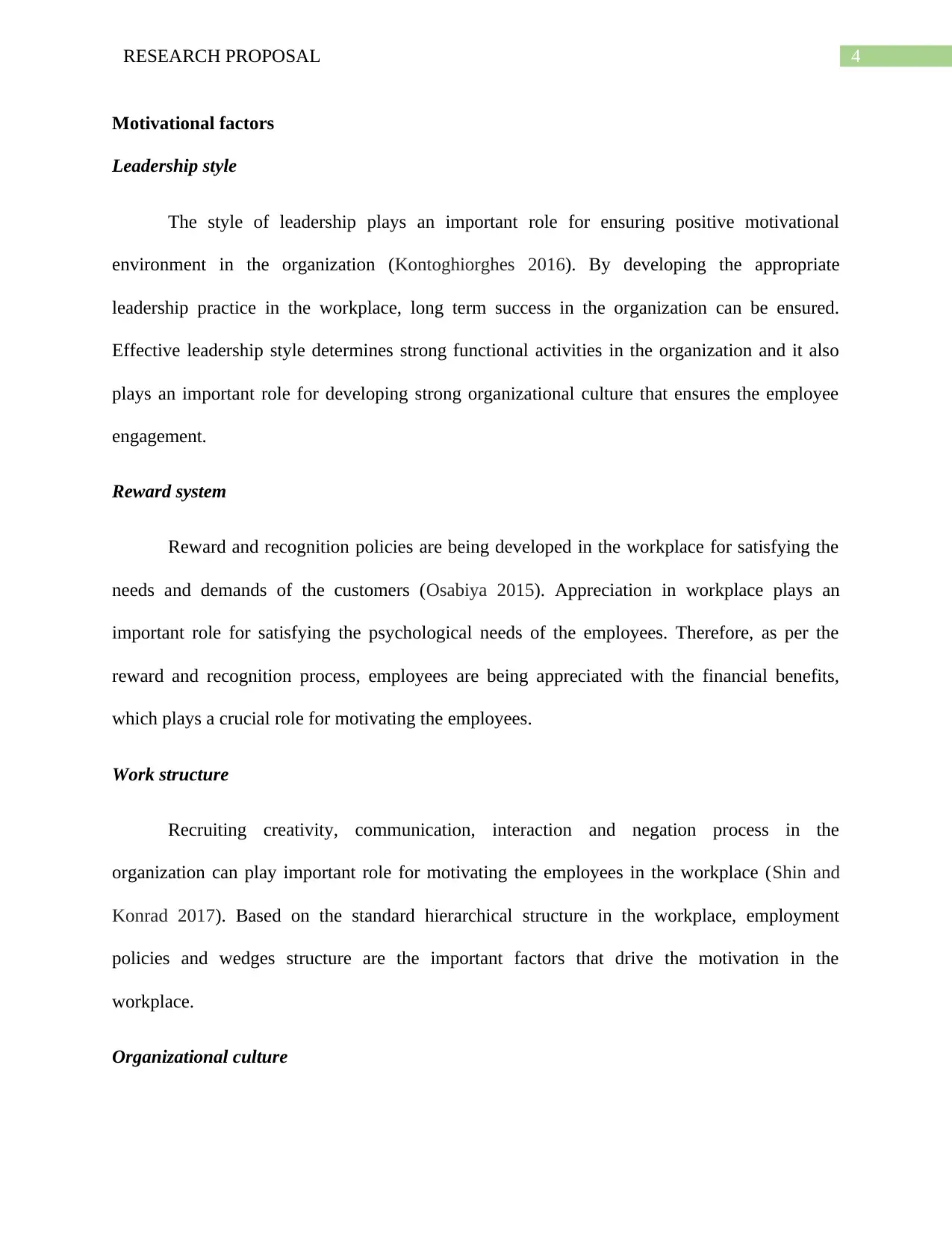
4RESEARCH PROPOSAL
Motivational factors
Leadership style
The style of leadership plays an important role for ensuring positive motivational
environment in the organization (Kontoghiorghes 2016). By developing the appropriate
leadership practice in the workplace, long term success in the organization can be ensured.
Effective leadership style determines strong functional activities in the organization and it also
plays an important role for developing strong organizational culture that ensures the employee
engagement.
Reward system
Reward and recognition policies are being developed in the workplace for satisfying the
needs and demands of the customers (Osabiya 2015). Appreciation in workplace plays an
important role for satisfying the psychological needs of the employees. Therefore, as per the
reward and recognition process, employees are being appreciated with the financial benefits,
which plays a crucial role for motivating the employees.
Work structure
Recruiting creativity, communication, interaction and negation process in the
organization can play important role for motivating the employees in the workplace (Shin and
Konrad 2017). Based on the standard hierarchical structure in the workplace, employment
policies and wedges structure are the important factors that drive the motivation in the
workplace.
Organizational culture
Motivational factors
Leadership style
The style of leadership plays an important role for ensuring positive motivational
environment in the organization (Kontoghiorghes 2016). By developing the appropriate
leadership practice in the workplace, long term success in the organization can be ensured.
Effective leadership style determines strong functional activities in the organization and it also
plays an important role for developing strong organizational culture that ensures the employee
engagement.
Reward system
Reward and recognition policies are being developed in the workplace for satisfying the
needs and demands of the customers (Osabiya 2015). Appreciation in workplace plays an
important role for satisfying the psychological needs of the employees. Therefore, as per the
reward and recognition process, employees are being appreciated with the financial benefits,
which plays a crucial role for motivating the employees.
Work structure
Recruiting creativity, communication, interaction and negation process in the
organization can play important role for motivating the employees in the workplace (Shin and
Konrad 2017). Based on the standard hierarchical structure in the workplace, employment
policies and wedges structure are the important factors that drive the motivation in the
workplace.
Organizational culture
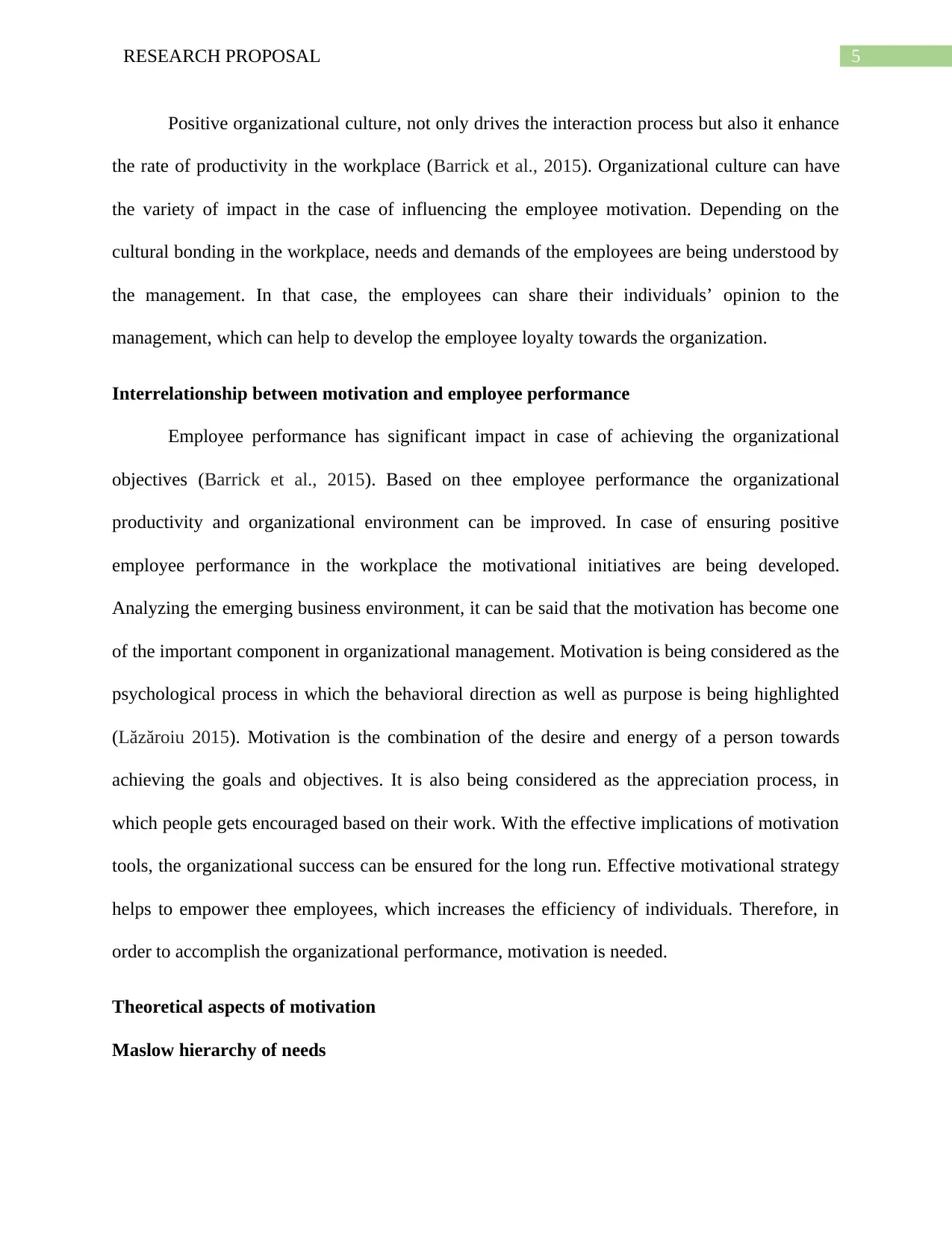
5RESEARCH PROPOSAL
Positive organizational culture, not only drives the interaction process but also it enhance
the rate of productivity in the workplace (Barrick et al., 2015). Organizational culture can have
the variety of impact in the case of influencing the employee motivation. Depending on the
cultural bonding in the workplace, needs and demands of the employees are being understood by
the management. In that case, the employees can share their individuals’ opinion to the
management, which can help to develop the employee loyalty towards the organization.
Interrelationship between motivation and employee performance
Employee performance has significant impact in case of achieving the organizational
objectives (Barrick et al., 2015). Based on thee employee performance the organizational
productivity and organizational environment can be improved. In case of ensuring positive
employee performance in the workplace the motivational initiatives are being developed.
Analyzing the emerging business environment, it can be said that the motivation has become one
of the important component in organizational management. Motivation is being considered as the
psychological process in which the behavioral direction as well as purpose is being highlighted
(Lăzăroiu 2015). Motivation is the combination of the desire and energy of a person towards
achieving the goals and objectives. It is also being considered as the appreciation process, in
which people gets encouraged based on their work. With the effective implications of motivation
tools, the organizational success can be ensured for the long run. Effective motivational strategy
helps to empower thee employees, which increases the efficiency of individuals. Therefore, in
order to accomplish the organizational performance, motivation is needed.
Theoretical aspects of motivation
Maslow hierarchy of needs
Positive organizational culture, not only drives the interaction process but also it enhance
the rate of productivity in the workplace (Barrick et al., 2015). Organizational culture can have
the variety of impact in the case of influencing the employee motivation. Depending on the
cultural bonding in the workplace, needs and demands of the employees are being understood by
the management. In that case, the employees can share their individuals’ opinion to the
management, which can help to develop the employee loyalty towards the organization.
Interrelationship between motivation and employee performance
Employee performance has significant impact in case of achieving the organizational
objectives (Barrick et al., 2015). Based on thee employee performance the organizational
productivity and organizational environment can be improved. In case of ensuring positive
employee performance in the workplace the motivational initiatives are being developed.
Analyzing the emerging business environment, it can be said that the motivation has become one
of the important component in organizational management. Motivation is being considered as the
psychological process in which the behavioral direction as well as purpose is being highlighted
(Lăzăroiu 2015). Motivation is the combination of the desire and energy of a person towards
achieving the goals and objectives. It is also being considered as the appreciation process, in
which people gets encouraged based on their work. With the effective implications of motivation
tools, the organizational success can be ensured for the long run. Effective motivational strategy
helps to empower thee employees, which increases the efficiency of individuals. Therefore, in
order to accomplish the organizational performance, motivation is needed.
Theoretical aspects of motivation
Maslow hierarchy of needs
⊘ This is a preview!⊘
Do you want full access?
Subscribe today to unlock all pages.

Trusted by 1+ million students worldwide
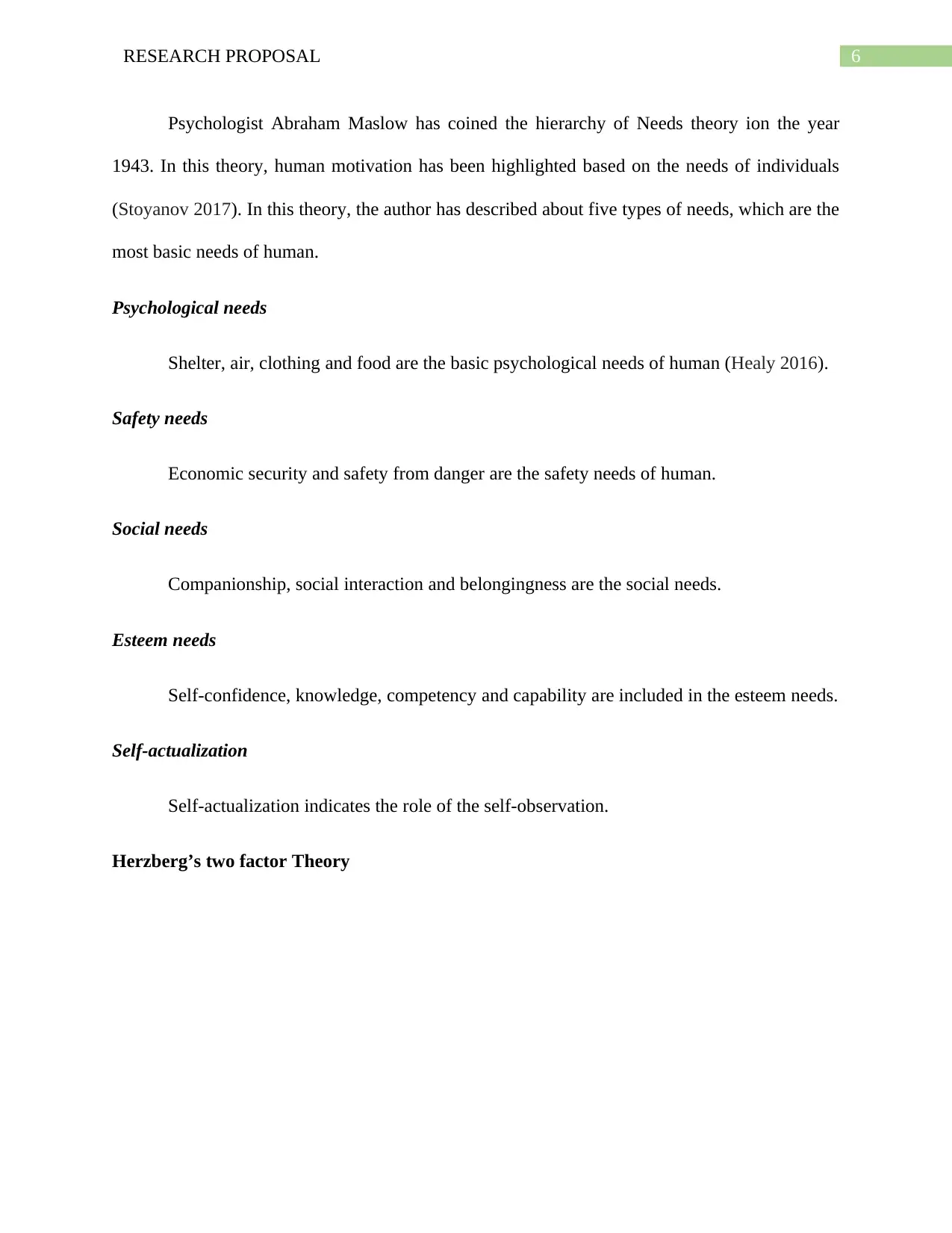
6RESEARCH PROPOSAL
Psychologist Abraham Maslow has coined the hierarchy of Needs theory ion the year
1943. In this theory, human motivation has been highlighted based on the needs of individuals
(Stoyanov 2017). In this theory, the author has described about five types of needs, which are the
most basic needs of human.
Psychological needs
Shelter, air, clothing and food are the basic psychological needs of human (Healy 2016).
Safety needs
Economic security and safety from danger are the safety needs of human.
Social needs
Companionship, social interaction and belongingness are the social needs.
Esteem needs
Self-confidence, knowledge, competency and capability are included in the esteem needs.
Self-actualization
Self-actualization indicates the role of the self-observation.
Herzberg’s two factor Theory
Psychologist Abraham Maslow has coined the hierarchy of Needs theory ion the year
1943. In this theory, human motivation has been highlighted based on the needs of individuals
(Stoyanov 2017). In this theory, the author has described about five types of needs, which are the
most basic needs of human.
Psychological needs
Shelter, air, clothing and food are the basic psychological needs of human (Healy 2016).
Safety needs
Economic security and safety from danger are the safety needs of human.
Social needs
Companionship, social interaction and belongingness are the social needs.
Esteem needs
Self-confidence, knowledge, competency and capability are included in the esteem needs.
Self-actualization
Self-actualization indicates the role of the self-observation.
Herzberg’s two factor Theory
Paraphrase This Document
Need a fresh take? Get an instant paraphrase of this document with our AI Paraphraser
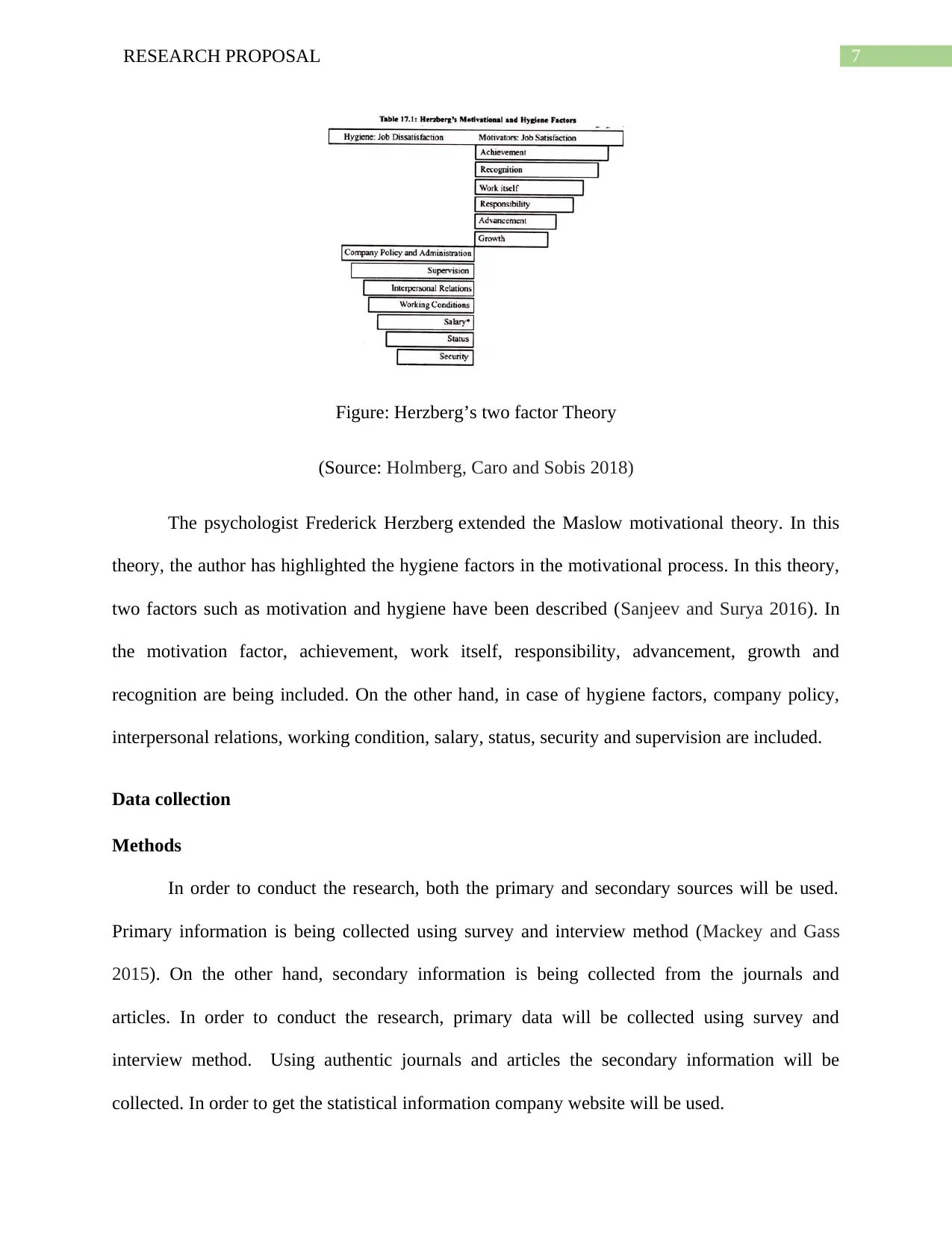
7RESEARCH PROPOSAL
Figure: Herzberg’s two factor Theory
(Source: Holmberg, Caro and Sobis 2018)
The psychologist Frederick Herzberg extended the Maslow motivational theory. In this
theory, the author has highlighted the hygiene factors in the motivational process. In this theory,
two factors such as motivation and hygiene have been described (Sanjeev and Surya 2016). In
the motivation factor, achievement, work itself, responsibility, advancement, growth and
recognition are being included. On the other hand, in case of hygiene factors, company policy,
interpersonal relations, working condition, salary, status, security and supervision are included.
Data collection
Methods
In order to conduct the research, both the primary and secondary sources will be used.
Primary information is being collected using survey and interview method (Mackey and Gass
2015). On the other hand, secondary information is being collected from the journals and
articles. In order to conduct the research, primary data will be collected using survey and
interview method. Using authentic journals and articles the secondary information will be
collected. In order to get the statistical information company website will be used.
Figure: Herzberg’s two factor Theory
(Source: Holmberg, Caro and Sobis 2018)
The psychologist Frederick Herzberg extended the Maslow motivational theory. In this
theory, the author has highlighted the hygiene factors in the motivational process. In this theory,
two factors such as motivation and hygiene have been described (Sanjeev and Surya 2016). In
the motivation factor, achievement, work itself, responsibility, advancement, growth and
recognition are being included. On the other hand, in case of hygiene factors, company policy,
interpersonal relations, working condition, salary, status, security and supervision are included.
Data collection
Methods
In order to conduct the research, both the primary and secondary sources will be used.
Primary information is being collected using survey and interview method (Mackey and Gass
2015). On the other hand, secondary information is being collected from the journals and
articles. In order to conduct the research, primary data will be collected using survey and
interview method. Using authentic journals and articles the secondary information will be
collected. In order to get the statistical information company website will be used.
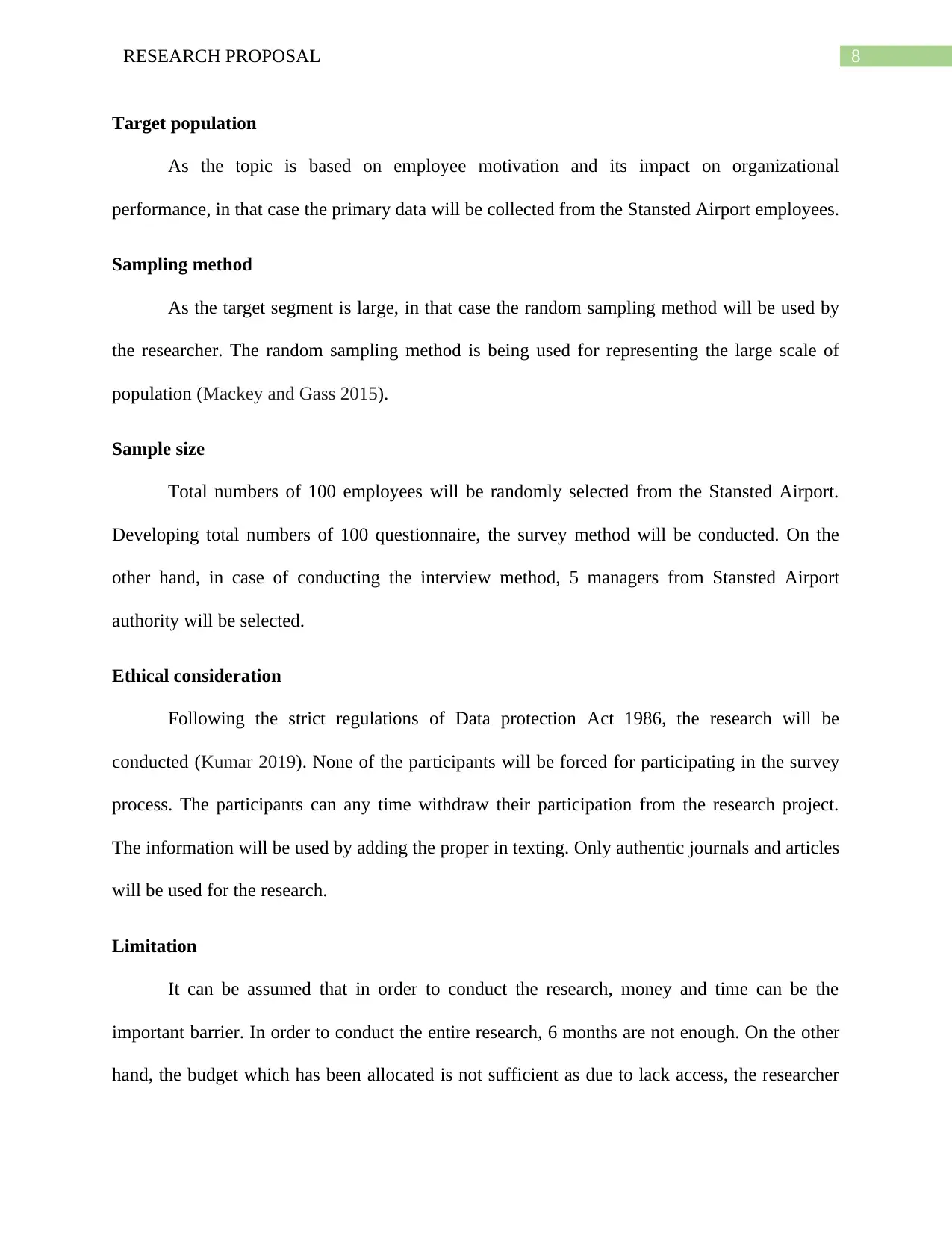
8RESEARCH PROPOSAL
Target population
As the topic is based on employee motivation and its impact on organizational
performance, in that case the primary data will be collected from the Stansted Airport employees.
Sampling method
As the target segment is large, in that case the random sampling method will be used by
the researcher. The random sampling method is being used for representing the large scale of
population (Mackey and Gass 2015).
Sample size
Total numbers of 100 employees will be randomly selected from the Stansted Airport.
Developing total numbers of 100 questionnaire, the survey method will be conducted. On the
other hand, in case of conducting the interview method, 5 managers from Stansted Airport
authority will be selected.
Ethical consideration
Following the strict regulations of Data protection Act 1986, the research will be
conducted (Kumar 2019). None of the participants will be forced for participating in the survey
process. The participants can any time withdraw their participation from the research project.
The information will be used by adding the proper in texting. Only authentic journals and articles
will be used for the research.
Limitation
It can be assumed that in order to conduct the research, money and time can be the
important barrier. In order to conduct the entire research, 6 months are not enough. On the other
hand, the budget which has been allocated is not sufficient as due to lack access, the researcher
Target population
As the topic is based on employee motivation and its impact on organizational
performance, in that case the primary data will be collected from the Stansted Airport employees.
Sampling method
As the target segment is large, in that case the random sampling method will be used by
the researcher. The random sampling method is being used for representing the large scale of
population (Mackey and Gass 2015).
Sample size
Total numbers of 100 employees will be randomly selected from the Stansted Airport.
Developing total numbers of 100 questionnaire, the survey method will be conducted. On the
other hand, in case of conducting the interview method, 5 managers from Stansted Airport
authority will be selected.
Ethical consideration
Following the strict regulations of Data protection Act 1986, the research will be
conducted (Kumar 2019). None of the participants will be forced for participating in the survey
process. The participants can any time withdraw their participation from the research project.
The information will be used by adding the proper in texting. Only authentic journals and articles
will be used for the research.
Limitation
It can be assumed that in order to conduct the research, money and time can be the
important barrier. In order to conduct the entire research, 6 months are not enough. On the other
hand, the budget which has been allocated is not sufficient as due to lack access, the researcher
⊘ This is a preview!⊘
Do you want full access?
Subscribe today to unlock all pages.

Trusted by 1+ million students worldwide
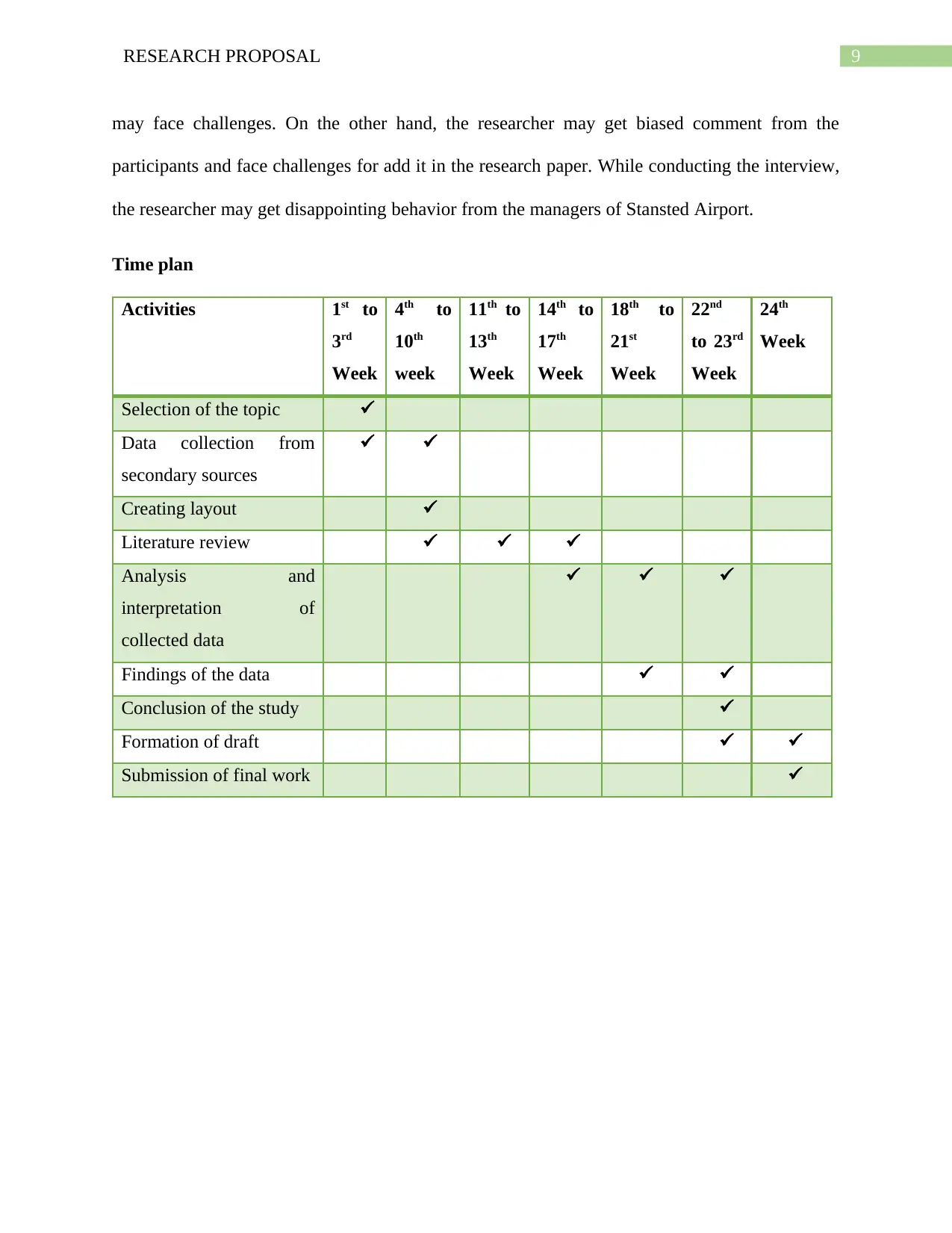
9RESEARCH PROPOSAL
may face challenges. On the other hand, the researcher may get biased comment from the
participants and face challenges for add it in the research paper. While conducting the interview,
the researcher may get disappointing behavior from the managers of Stansted Airport.
Time plan
Activities 1st to
3rd
Week
4th to
10th
week
11th to
13th
Week
14th to
17th
Week
18th to
21st
Week
22nd
to 23rd
Week
24th
Week
Selection of the topic
Data collection from
secondary sources
Creating layout
Literature review
Analysis and
interpretation of
collected data
Findings of the data
Conclusion of the study
Formation of draft
Submission of final work
may face challenges. On the other hand, the researcher may get biased comment from the
participants and face challenges for add it in the research paper. While conducting the interview,
the researcher may get disappointing behavior from the managers of Stansted Airport.
Time plan
Activities 1st to
3rd
Week
4th to
10th
week
11th to
13th
Week
14th to
17th
Week
18th to
21st
Week
22nd
to 23rd
Week
24th
Week
Selection of the topic
Data collection from
secondary sources
Creating layout
Literature review
Analysis and
interpretation of
collected data
Findings of the data
Conclusion of the study
Formation of draft
Submission of final work
Paraphrase This Document
Need a fresh take? Get an instant paraphrase of this document with our AI Paraphraser
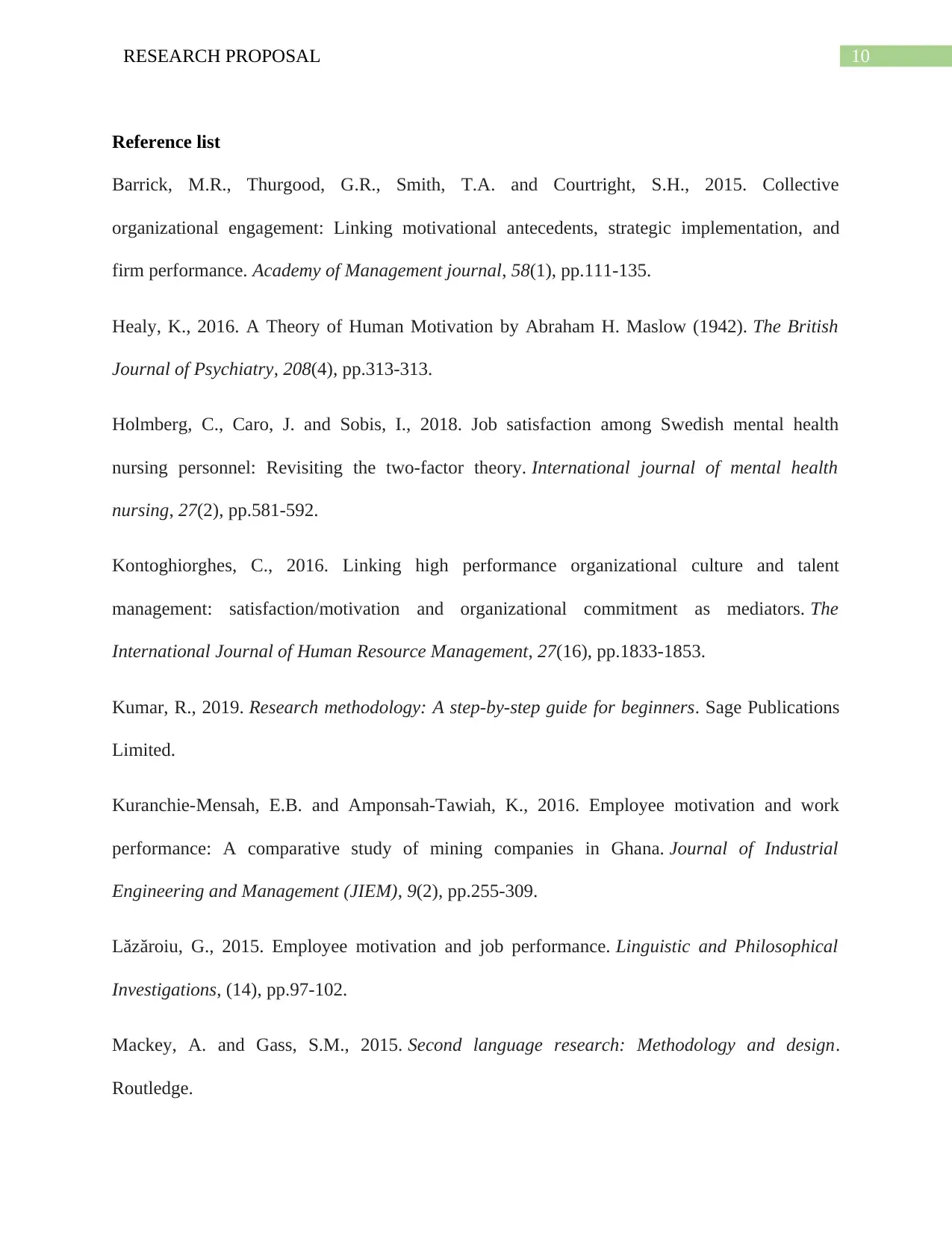
10RESEARCH PROPOSAL
Reference list
Barrick, M.R., Thurgood, G.R., Smith, T.A. and Courtright, S.H., 2015. Collective
organizational engagement: Linking motivational antecedents, strategic implementation, and
firm performance. Academy of Management journal, 58(1), pp.111-135.
Healy, K., 2016. A Theory of Human Motivation by Abraham H. Maslow (1942). The British
Journal of Psychiatry, 208(4), pp.313-313.
Holmberg, C., Caro, J. and Sobis, I., 2018. Job satisfaction among Swedish mental health
nursing personnel: Revisiting the two‐factor theory. International journal of mental health
nursing, 27(2), pp.581-592.
Kontoghiorghes, C., 2016. Linking high performance organizational culture and talent
management: satisfaction/motivation and organizational commitment as mediators. The
International Journal of Human Resource Management, 27(16), pp.1833-1853.
Kumar, R., 2019. Research methodology: A step-by-step guide for beginners. Sage Publications
Limited.
Kuranchie-Mensah, E.B. and Amponsah-Tawiah, K., 2016. Employee motivation and work
performance: A comparative study of mining companies in Ghana. Journal of Industrial
Engineering and Management (JIEM), 9(2), pp.255-309.
Lăzăroiu, G., 2015. Employee motivation and job performance. Linguistic and Philosophical
Investigations, (14), pp.97-102.
Mackey, A. and Gass, S.M., 2015. Second language research: Methodology and design.
Routledge.
Reference list
Barrick, M.R., Thurgood, G.R., Smith, T.A. and Courtright, S.H., 2015. Collective
organizational engagement: Linking motivational antecedents, strategic implementation, and
firm performance. Academy of Management journal, 58(1), pp.111-135.
Healy, K., 2016. A Theory of Human Motivation by Abraham H. Maslow (1942). The British
Journal of Psychiatry, 208(4), pp.313-313.
Holmberg, C., Caro, J. and Sobis, I., 2018. Job satisfaction among Swedish mental health
nursing personnel: Revisiting the two‐factor theory. International journal of mental health
nursing, 27(2), pp.581-592.
Kontoghiorghes, C., 2016. Linking high performance organizational culture and talent
management: satisfaction/motivation and organizational commitment as mediators. The
International Journal of Human Resource Management, 27(16), pp.1833-1853.
Kumar, R., 2019. Research methodology: A step-by-step guide for beginners. Sage Publications
Limited.
Kuranchie-Mensah, E.B. and Amponsah-Tawiah, K., 2016. Employee motivation and work
performance: A comparative study of mining companies in Ghana. Journal of Industrial
Engineering and Management (JIEM), 9(2), pp.255-309.
Lăzăroiu, G., 2015. Employee motivation and job performance. Linguistic and Philosophical
Investigations, (14), pp.97-102.
Mackey, A. and Gass, S.M., 2015. Second language research: Methodology and design.
Routledge.
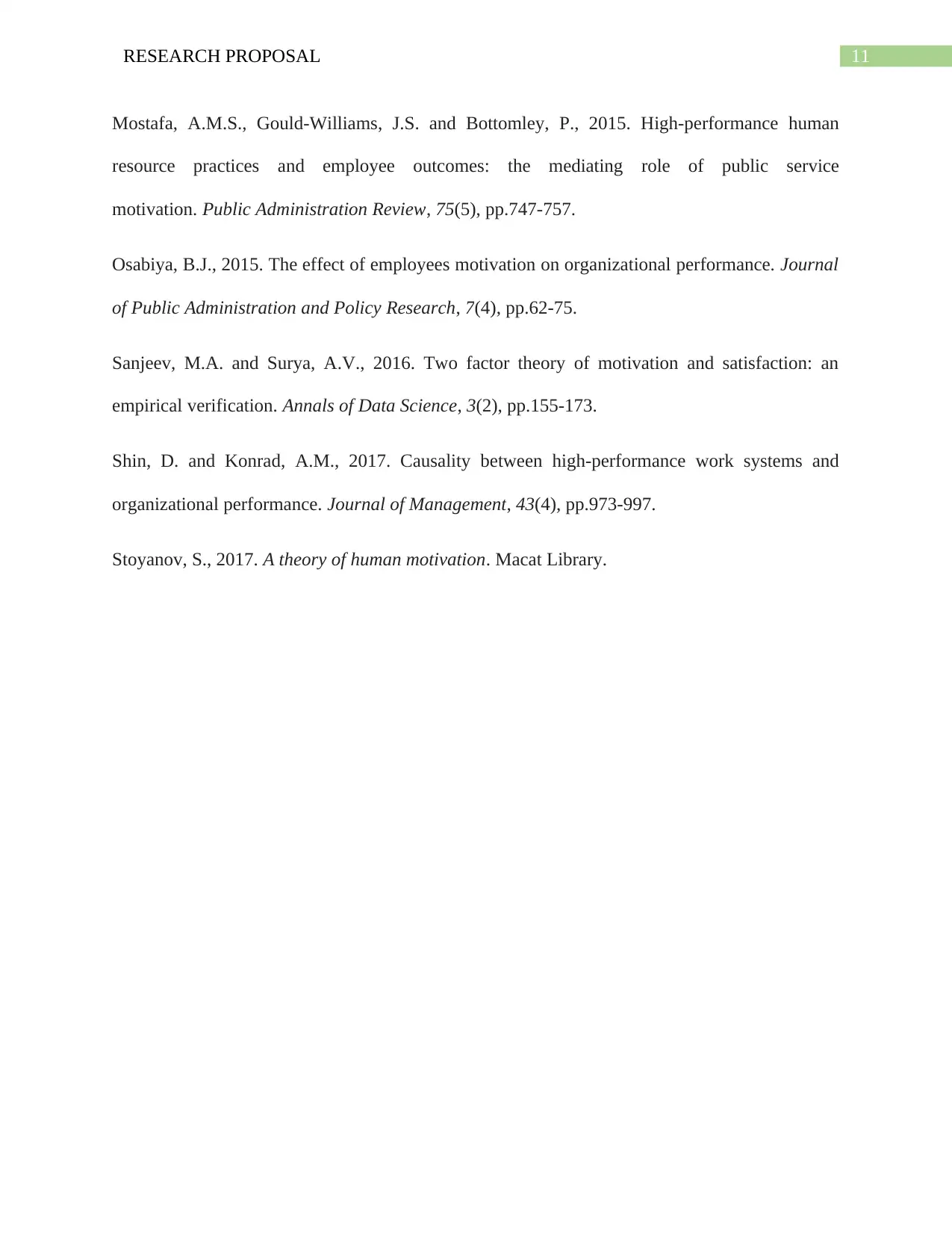
11RESEARCH PROPOSAL
Mostafa, A.M.S., Gould‐Williams, J.S. and Bottomley, P., 2015. High‐performance human
resource practices and employee outcomes: the mediating role of public service
motivation. Public Administration Review, 75(5), pp.747-757.
Osabiya, B.J., 2015. The effect of employees motivation on organizational performance. Journal
of Public Administration and Policy Research, 7(4), pp.62-75.
Sanjeev, M.A. and Surya, A.V., 2016. Two factor theory of motivation and satisfaction: an
empirical verification. Annals of Data Science, 3(2), pp.155-173.
Shin, D. and Konrad, A.M., 2017. Causality between high-performance work systems and
organizational performance. Journal of Management, 43(4), pp.973-997.
Stoyanov, S., 2017. A theory of human motivation. Macat Library.
Mostafa, A.M.S., Gould‐Williams, J.S. and Bottomley, P., 2015. High‐performance human
resource practices and employee outcomes: the mediating role of public service
motivation. Public Administration Review, 75(5), pp.747-757.
Osabiya, B.J., 2015. The effect of employees motivation on organizational performance. Journal
of Public Administration and Policy Research, 7(4), pp.62-75.
Sanjeev, M.A. and Surya, A.V., 2016. Two factor theory of motivation and satisfaction: an
empirical verification. Annals of Data Science, 3(2), pp.155-173.
Shin, D. and Konrad, A.M., 2017. Causality between high-performance work systems and
organizational performance. Journal of Management, 43(4), pp.973-997.
Stoyanov, S., 2017. A theory of human motivation. Macat Library.
⊘ This is a preview!⊘
Do you want full access?
Subscribe today to unlock all pages.

Trusted by 1+ million students worldwide
1 out of 12
Related Documents
Your All-in-One AI-Powered Toolkit for Academic Success.
+13062052269
info@desklib.com
Available 24*7 on WhatsApp / Email
![[object Object]](/_next/static/media/star-bottom.7253800d.svg)
Unlock your academic potential
Copyright © 2020–2025 A2Z Services. All Rights Reserved. Developed and managed by ZUCOL.





